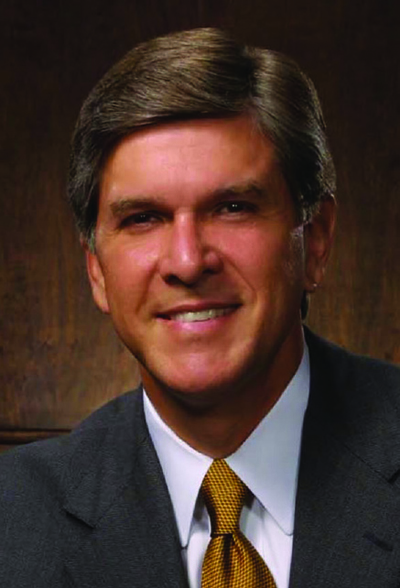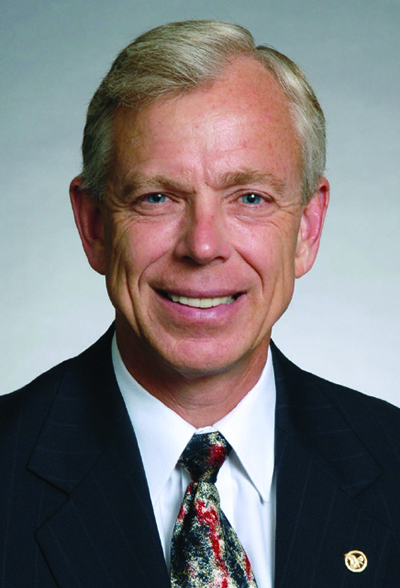NAB Show: Content’s Level Playing Field
LAS VEGAS—The most remarkable thing about the annual NAB Show, April 8-11 in Las Vegas, is the “Petri dish” environment that comes from squeezing a year’s worth of thrills, disappointments and predictions into one six-day stretch. It offers a microscopic look at what’s been brewing—what worked and what clearly did not—over the last 12 months.
As the industry evolves and trends change, the show has as well. No longer a convention targeted just to the broadcast professional, the 2013 gathering has been retooled to address the very different world that is now the prevue of the professional media individual.


Gordon Smith (L), NAB president and CEO, will discuss the future of media with Lowell C. McAdam, chairman and CEO of Verizon Communications during Tuesday’s General Session.
Over the last few years, the show has been revamped to address the issues of a network engineer as surely as it welcomes the social media marketer. That’s a marked difference from the NAB you’d have walked in on a decade ago, when the digital transition was still underway and it was doubly clear who were the allies and who were the competitors.
4K FRONT AND CENTER
What’s leveling the playing field? Content itself.
Content has pushed the show to usher in a new breed of companies as well as create new areas of focus—areas like the Connected Media World and the Enterprise Computing Pit (see “NAB Show Expands Tech Focus,”).
This year, 4K technology will sit in the spotlight. Like its HD forefather, 4K continues to make inroads because of the format’s promise of higher-resolution images and crystal clarity. At the show, camera manufacturers and storage developers are expected to offer 4K-ready solutions this year that don’t abandon existing technology, like a 1080p 4K server from Abekas that can import a 4K file and create 1080p files for playback on 3G HD/SDI outputs. Other companies plan to demonstrate how their existing behind-the-scenes solutions are themselves already suitable for 4K production, from routing to monitoring technologies.
Get the TV Tech Newsletter
The professional video industry's #1 source for news, trends and product and tech information. Sign up below.
Though consumer demand for 4K is limited, the technology has vocal supporters. Earlier this year, Japan announced its intention to transmit the world’s first 4K television broadcast in July 2014 during its coverage of the World Cup in Brazil.
“The goal is always to try and both reflect and tease the latest trends in every aspect of what happens at the show, from exhibit floor to conference sessions to organic dialogue,” said Chris Brown, executive vice president of conventions for NAB.
As much as we have all found standard HD to be pretty amazing, 4K is a true nextlevel viewing experience,” Brown said. “The industry as a whole seems ot be gearing rapidly for a shift to this next generation technology and it does appear to have moved beyond rhetoric at this point, although it will no doubt take several years to move all sides of the ecosystem through the transition.”
NAB will also tout another first: A live 8K broadcast at the NHK exhibit as part of the NAB Futures Park, which looks at technologies that are a generation or so away from what’s available today.
Another area of growth: technology that addresses social media. Like so many technologies before it, the cocktail of social media and broadcasting has trodden a sometimes- rocky path.
SECOND SCREEN STRATEGY
This year, when it comes to social media, there’s an effort to offer some clarity. A growing number of companies are working to make the actual means of sharing the sometimes-disjointed messages from the separate worlds of Twitter and Facebook in a way that’s more broadcast friendly. Sessions at the show seem to take two views: on one hand, stripping away the mystery of just how to integrate social media into a broadcast. On the other, delving into the psychology of social media to explain why it’s become such a powerful communications tool. Other sessions will look at better ways to use social media to build loyalty.
“Social media isn’t this Holy Grail, it’s a tool,” said Alexandra Gebhardt, founder of the firm Inside Media Networks, who will speak Sunday, April 7 at Web 3.0: Social Media & Web Video. The error is to treat social media as a separate entity, rather than incorporating it into part of a regular media plan. Rather, it needs to become an extension of how human beings interact, she said.
“With any kind of technical shift, you’re going to have this period of disbelief,” said Gebhardt. “But it’s important to stay on top of all that. [The industry] needs to incorporate the second screen as a strategy. Content has and always will be king, but now we can absorb it any way we want.”
In the same vein, the show will again have a strong focus on second-screen devices and mobile TV. There remains steady support for the launch of mobile TV, even as the service rollout nationwide is still in progress. Late last year, mobile TV advocacy group Open Mobile Video Coalition announced that it was putting its advocacy efforts into the NAB organization as part of the “next logical step,” according to Anne Schelle, the organization’s former executive director. At this year’s show, NAB sessions will offer an update on the rollout of mobile TV, with a review of ongoing technical standards updates.
3D REMAINS STRONG
Another benefit of the annual convention is that it gives the industry a chance to re-evaluate its stance on technologies, both those that are promising and those that are struggling. Despite an undercurrent of doubt that has sometimes followed the 3D rollout, the 3D trend forecast for 2013 stressed that this young digital technology continues to capture significant revenue. “The 3D worldwide infrastructure is steadily building,” said Jim Chabin, president of the International 3D Society.
In additional to the more than 40 3D features that are expected to be released in 2013, the organization anticipates rapid growth in 3DTV sets with more than 60 million sets in the U.S. by 2016, he said. “4K and smart TVs are both technologies that will further enable a great 3D experience for consumers,” the forecast said.
“Most large-screen TVs being shipped are 3D ready; ESPN3D is broadcasting the Masters in April and the 3Net [3D channel] has the biggest 3D library in the world at this point, so the content is building and consumer surveys show that they like what they see but want more,” Chabin said. “We have a heck of a platform for shrewd programmers who want to have a competitive edge over their rivals.”
The launch of 4K 3DTV screens will provide even brighter, 3D viewing experiences, Chabin said. “4K is dazzling and makes 3D better, brighter and more exciting,” he said, pointing to the planned 3D broadcast of the 2014 Winter Games.
Convention organizers believe so as well, with the convention targeting 3D technology with the Technology Summit On Cinema, April 6–7, which will look at the history of cinema technology and the pitfalls sometimes associated with 3D. In addition there will be workshops that touch on 3D issues, from modeling software that makes 3D possible as well as the problems inherent with 3D conversion.
While broadcasters and media companies collaborate on developing models for the next generation of media devices and delivery pipes, broadcasters are keeping tabs on the FCC’s efforts to remodel the spectrum landscape with upcoming auctions. In the wake of this uncertainty, stations are weighing their future viability and relevance in an environment in which the majority of media is now being distributed over IP.
A majority of broadcasters, though, remain committed to the medium and it is to that end that the NAB has made it its mission to protect signal integrity throughout the process. Sessions including “Spectrum Matters,” at the Broadcasting Engineering Conference on Monday morning, April 8, and “Incentive Auctions of TV Spectrum— How and When They Will Impact Your Business,” Monday afternoon, will delve into the details surrounding the spectrum repacking process that result from the auctions.
CONSUMER IN CONTROL
Like puzzle pieces in a box, the industry continues to watch as the broadcast/cable/ streaming market is shaken up. Although the shuffling of players and services continues— a confusing jumble of former competitors turning into allies, while simultaneously remaining opponents—the controlling hand continues to be the consumer, who continues to want an integrated mix of apps and content on multiple devices.
The industry is also continuing to mull the benefits of cloud computing. How can this relatively inexpensive means of storing and delivering information be used—reliably— to enable distribution and playback on multiple fixed and mobile platforms? Sessions like “Content Delivery from the Cloud” (Monday, April 8), will look at the ways cloud computing can be used to improve the idea of a TV-everywhere world.
“Our customers are extremely keen to understand how what this cloud can do for them,” said Paul Martin, president of Snell North America, one of many exhibitors who will be showcasing new cloud computing solutions at this year’s show. The U.K. company will demonstrate how its technology can improve workflow, starting from the raw materials and running through the final result playing on a consumer device. “We’re going to show how you can do that all through a fully automated cloud-based capability,” Martin said.
The show will further embrace the “disruptive” among us with the Disruptive Media Conference, which will look at how broadcasters can better partner with the newcomers of the content distribution world to ferret out challenges and untapped opportunities. Late last year YouTube announced it would launch a branded channel initiative that would offer a mix of original content and aggregated clips, attempting to wrest further control of the viewing markets from traditional broadcasters. Panels like “The Future of Online Video” (Thursday, April 11), will look at how these so-called threats could really be opportunities to bond with new distribution partners.
The NAB will again tout its ties with the media and entertainment scene, tapping entertainment journalist Nancy O’Dell to host the NAB Television Luncheon. The show is also reaching across the aisle by welcoming the CEO of Verizon Communications, Lowell C. McAdam, to headline the show’s General Session. NAB President Gordon Smith, who will speak alongside News Corp. CEO Chase Carey, will give the annual State of the Broadcast Industry address.
For more information, visit www.nabshow.com.
Susan Ashworth is the former editor of TV Technology. In addition to her work covering the broadcast television industry, she has served as editor of two housing finance magazines and written about topics as varied as education, radio, chess, music and sports. Outside of her life as a writer, she recently served as president of a local nonprofit organization supporting girls in baseball.

